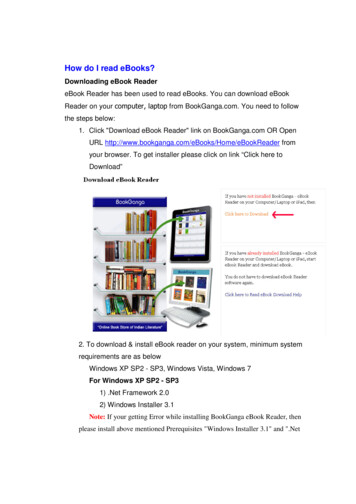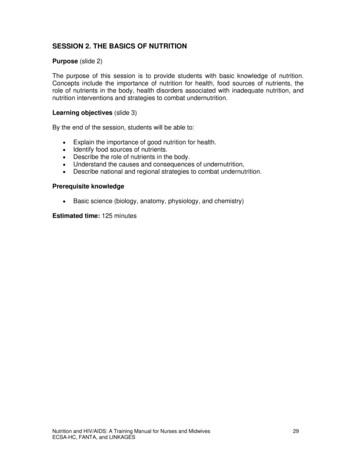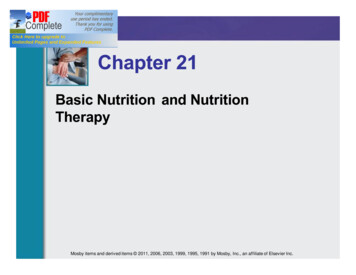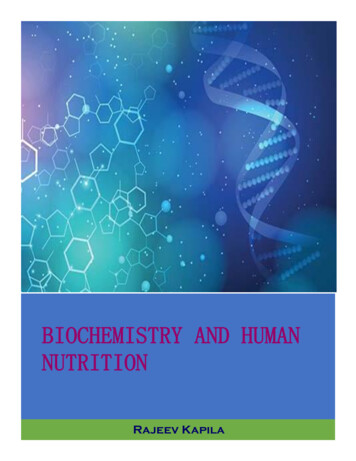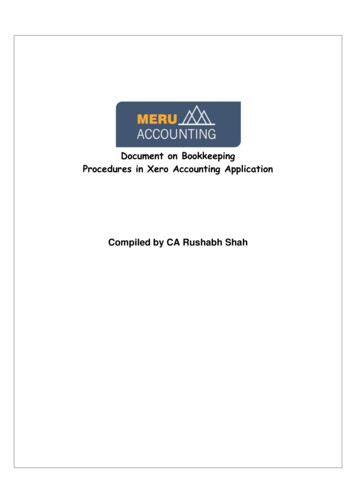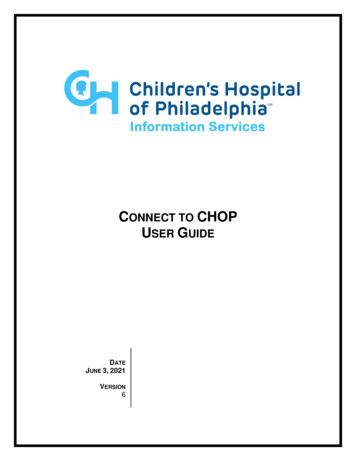
Transcription
Final PDF to printerHuman Nutrition:Science for Healthy Living Updated with2015–2020 Dietary Guidelines for AmericansTammy J. Stephenson PhDUniversity of KentuckyWendy J. Schiff MS, RDNste16839 fm i-xxvi.inddi03/30/16 02:57 PM
Final PDF to printerHUMAN NUTRITION: SCIENCE FOR HEALTHY LIVING Updated with 2015-2020 DietaryGuidelines for AmericansPublished by McGraw-Hill Education, 2 Penn Plaza, New York, NY 10121. Copyright 2016 byMcGraw-Hill Education. All rights reserved. Printed in the United States of America. No part of thispublication may be reproduced or distributed in any form or by any means, or stored in a database orretrieval system, without the prior written consent of McGraw-Hill Education, including, but not limitedto, in any network or other electronic storage or transmission, or broadcast for distance learning.Some ancillaries, including electronic and print components, may not be available to customers outside theUnited States.This book is printed on acid-free paper.1 2 3 4 5 6 7 8 9 DOW/DOW 21 20 19 18 17 16ISBN 978-1-259-91683-0MHID 1-259-91683-9Senior Vice President, Products & Markets: Kurt L. StrandVice President, General Manager, Products & Markets: Marty LangeVice President, Content Design & Delivery: Kimberly Meriwether DavidManaging Director: Michael S. HackettDirector of Digital Content: Michael G. Koot, PhDBrand Managers: Marija Magner/Amy ReedDirector, Product Development: Rose KoosProduct Developer: Darlene SchuellerMarketing Manager: Kristine RellihanDigital Product Analyst: Christine CarlsonDirector, Content Design & Delivery: Linda AvenariusProgram Manager: Angela R. FitzPatrickContent Project Managers: Mary Jane Lampe/Brent Dela CruzBuyer: Jennifer PickelDesigners: Michelle D. Whitaker/Matt BackhausContent Licensing Specialists: Lori Hancock (images)/Lorraine Buczek (text)Cover Image: 237/Anthony Lee/Ocean/Corbis/RFCompositor: SPi GlobalPrinter: R. R. DonnelleyAll credits appearing on page or at the end of the book are considered to be an extension of the copyrightpage.Library of Congress Cataloging-in-Publication DataNames: Stephenson, Tammy J. Schiff, Wendy.Title: Human nutrition: science for healthy living / Tammy J. Stephenson, Ph.D.,Wendy J. Schiff, M.S., R.D.FPO.Description: Updated with 2015-2020 dietary guidelines for Americans. New York, NY:McGraw-Hill Education, c2016. Includes index.Identifiers: LCCN 2016008800 ISBN 9781259916830 (alk. paper)Subjects: LCSH: Human nutrition—Textbooks.Classification: LCC QP141 .S647 2016b DDC 612.3—dc23LC record available at https://lccn.loc.gov/2016008800The Internet addresses listed in the text were accurate at the time of publication. The inclusion ofa website or photo or mention of a specific product does not indicate an endorsement by the authorsor McGraw-Hill Education, and McGraw-Hill Education does not guarantee the accuracy of theinformation presented at these sites.www.mhhe.comste16839 fm i-xxvi.inddii04/04/16 08:20 PM
Final PDF to printerAbout the AuthorsTammy J. Stephenson, PhD,Wendy J. Schiff, MS, RDN,received her BS in Food Sciencereceived her BS in Biologicalin Nutritional Sciences fromand MS in Human Nutritionand Human Nutrition and PhDHealth/Medical Dieteticsthe University of Kentucky.from The Pennsylvania StateShe has taught a wide varietyUniversity. She has taughtof food, nutrition, and wellnesscourses, including introductory nutrition, to majors andintroductory food and nutritioncourses at the University ofnonmajors in the Department of Dietetics and HumanMissouri–Columbia as well as nutrition, biology, and15 years. Dr. Stephenson is an active member of theMeramec. She has worked as a public health nutritionistNutrition at the University of Kentucky for the pastAcademy of Nutrition and Dietetics, serving as Chair ofthe Nutrition Educators of Health Professionals practicegroup. She has published and presented on servicelearning, technology in teaching, student-centeredlearning, and other related topics. Dr. Stephenson has apassion for teaching engaging, interesting, and relevantnutrition courses that has been recognized throughmultiple teaching and mentoring awards at the university,state, and national levels. Outside of the classroom, sheenjoys running, yoga, coaching youth soccer, gardening,personal health courses at St. Louis Community College–at the Allegheny County Health Department (Pittsburgh,Pennsylvania) and State Food and Nutrition Specialistfor Missouri Extension at Lincoln University in JeffersonCity, Missouri. In addition to coauthoring HumanNutrition: Science for Healthy Living, Wendy hasauthored Nutrition for Healthy Living and NutritionEssentials: A Personal Approach. She is a registereddietitian nutritionist and member of the Academy ofNutrition and Dietetics.cooking, and spending time with her family.To Brian, Bailey, Kylie Mae,and AnsleyTo Bill and Kevin—Wendy Schiff—Tammy Stephensoniiiste16839 fm i-xxvi.inddiii03/30/16 02:57 PM
Final PDF to printerWelcome to Human Nutrition:Science for Healthy LivingUpdated with the 2015–2020Dietary Guidelines for AmericansDear Students,Welcome to the study of human nutrition! Before you begin your studies, it isimportant to understand that nutrition is a science that draws upon knowledgefrom other sciences, particularly biology, human anatomy and physiology,general chemistry, and biological chemistry. The science of human nutrition alsoinvolves learning scientific information about foods and nutrition, and how thisinformation is used to develop dietary recommendations for healthy people andnutritional therapies for those who are not healthy. By understanding thecontents of this introductory nutrition textbook, you will recognize the effectsthat peoples’ food choices can have on their health. In addition, you willappreciate the valuable role that registered dietitian nutritionists (RDNs) playas members of the health care team and be well prepared to take moreadvanced human nutrition courses, if you decide to become a dietitian.Human Nutrition: Science for Healthy Living has been developed by a teamof nutrition educators who have extensive college teaching experience and apassion for teaching relevant, student-centered nutrition, foods, health, andwellness courses. Our overall goal is to prepare you for your career in a healthcare discipline, and we want you to enjoy your introductory study of humannutrition. Learning about any science can be challenging if the information isnot presented in an appealing, interesting manner. We’ve made a distinct effortto write the content of this book in an understandable way and to provide cleardescriptions of concepts that can be difficult to convey, such as the processes ofdigestion, absorption, and energy metabolism. To enhance your learning,numerous meaningful illustrations and photographs accompany the narrative.Such graphics facilitate learning for all students, but especially for those whoare “visual learners.” By reviewing pages xv-xxiv of this Preface, you will learnabout the features of this book and how to use them to facilitate your study ofhuman nutrition.We hope you will enjoy using this textbook!ivste16839 fm i-xxvi.inddiv03/30/16 02:57 PM
Final PDF to printerBrief ContentsPreface xv1234567891011121314151617181920Introduction to Nutrition 1Evaluating Nutrition Information 25Basis of a Healthy Diet 44Human Digestion, Absorption, and Transport 79Carbohydrates: Sugars, Starches, and Fiber 110Lipids: Triglycerides, Phospholipids, and Sterols 149Proteins: Amino Acids 189Metabolism 227Vitamin Overview and Fat-Soluble Vitamins 267Water-Soluble Vitamins 303Water and Major Minerals 342Trace Minerals 383Obesity, Energy Balance, and Weight ManagementEating Disorders and Disordered Eating 459Nutrition for Fitness and Sport 480Pregnancy and Lactation 525Infants, Children, and Adolescents 553Nutrition for Older Adults 581Food and Water Safety 604Global Nutrition 640416Appendix A English-Metric Conversions and Metric-to-Household Units A-3Appendix B Basic Chemistry Concepts A-5Appendix C Basic Anatomy and Physiology Concepts A-9Appendix D Major Monosaccharides, Amino Acids, and Vitamins A-13Appendix E Vitamins Involved in Energy Metabolism A-21Appendix F Nutrition Assessment A-23Appendix G Daily Values Table A-33Appendix H Canada’s Food Guide A-35Appendix I Food Composition Table A-41Glossary G-1Credits C-1Index I-1Dietary Reference Intakes (DRIs)ste16839 fm i-xxvi.inddvv03/30/16 02:57 PM
Final PDF to printerContentsPreface xv1 Introduction to Nutrition1.1The Importance of Nutrition 2Why Study Nutrition? 2How to Use This Textbook 21.2The Nutrients 3The Six Classes of Nutrients 3Nutrients: Elements 4Essential Nutrients 5Macronutrients and Micronutrients 6Phytochemicals 61.3Food as Fuel 7Direct Calorimetry 8Calculating Food Energy 81.4Does Diet Matter? 9Risk Factors 91.5Factors That InfluenceEating Habits 11Biological and Physiological Factors 12Cognitive and Psychological Factors 12Environmental Factors 131.61Key Nutrition Concepts 13Concept 1: Most Foods Are Mixtures ofNutrients 14Concept 2: Variety, Moderation, and BalanceCan Help Ensure a Diet’s NutritionalAdequacy 15Concept 3: Food Is the Best Source ofNutrients 15Concept 4: Foods and the Nutrients TheyContain Are Not Cure-Alls 17Concept 5: Malnutrition Includes Overnutritionas Well as Undernutrition 18Concept 6: Nutrition Is a DynamicScience 18Summary 192 Evaluating NutritionInformation 252.1Dr. Goldberger’s Discovery 26Identification of the Missing DietarySubstance 262.2Understanding the Scientific Method 27Animal Research: Laboratory Experiments 27Human Research: Experimental (Intervention)Studies 29Human Research: EpidemiologicalStudies 30Limitations of Nutrition-Related Studies 31Reporting Findings 33Following Up with More Research 342.3Nutrition Information: Fact or Fiction 35Ask Questions 36Using the Internet Wisely 37Directing Questions at Reliable Experts 382.4 Nutrition Experts: RegisteredDietitians 39Becoming a Registered Dietitian/Nutritionist 39Summary 403 Basis of a Healthy Diet443.1What Is a Nutrient Requirement? 453.2Dietary Reference Intakes: Nutrient andCalorie Standards 45Estimated Average Requirement 46Recommended Dietary Allowances 46Adequate Intakes 46Tolerable Upper Intake Level 47Acceptable Macronutrient DistributionRanges 47Applying Nutrient Standards 47viste16839 fm i-xxvi.inddvi03/30/16 02:57 PM
Final PDF to printer3.3 Major Food Groups 49Grains 49Dairy Foods 50Protein Foods 50Fruits 50Vegetables 50Oils 51Empty-Calorie Foods or Beverages 513.4 U.S. Dietary Guidelines 52Summary of the 2015–2020 DietaryGuidelines for Americans 53Applying the Dietary Guidelines 543.5 Food Guides for Dietary Planning 55MyPlate 56Other Menu-Planning Tools 593.6 Food and Dietary Supplement Labels 60Daily Values 61Nutrition Facts Panel 61Rating Foods for Nutritional Value 63Health Claims 64Structure/Function Claims 64Nutrient Content Claims 64Other Descriptive Labeling Terms 65Dietary Supplement Labels 66Organic Food 673.7 Food and Culture: The Melting Pot 68African Heritage Diets 70Religious Influences 72Summary 734 Human Digestion, Absorption,and Transport 79Overview of the Digestive System 80The Wall of the GI Tract 80Sphincters Control the Flow of GI Contents 80Mechanical and Chemical Digestion 814.2 The Mouth 82Salivary Glands 82Taste Buds 82Disorders of Taste and Smell 834.3 The Esophagus 85Choking 85Peristalsis 864.4 The Stomach 87Secretions of the Stomach 87Digestion in the Stomach 884.5 The Small Intestine 90Accessory Organs: The Liver, Gallbladder, andPancreas 90Digestion in the Small Intestine 91Nutrient Absorption and Transport 924.6 The Large Intestine 94Functions of the Large Intestine 944.7Microbes in the Digestive Tract 96Actions of Intestinal Bacteria 96Probiotics and Prebiotics 964.8 Hormonal Regulation of Digestion 98Gastrin, Secretin, and Cholecystokinin 984.9 Common Digestive Tract Disorders 99Constipation 99Diarrhea 100Vomiting 100Heartburn 101Peptic Ulcer 102Irritable Bowel Syndrome 103Inflammatory Bowel Disease 103Summary 1055 Carbohydrates: Sugars,Starches, and Fiber 1105.1Introducing Carbohydrates 1115.2Simple Carbohydrates 112Monosaccharides 112Disaccharides 113What Is High-Fructose Corn Syrup? 114Nutritive Sweeteners 114Alternative Sweeteners 1155.3Complex Carbohydrates 118Oligosaccharides 118Starch and Glycogen 118Fiber 1194.15.4 Carbohydrate Consumption Patterns 121Added Sugar Consumption 1225.5Carbohydrates: Digestion andAbsorption 123Carbohydrate Digestion 123Carbohydrate Absorption 124Fiber 124viiste16839 fm i-xxvi.inddvii04/01/16 03:19 PM
Final PDF to printer5.6Maintaining Normal Blood Glucose Levels 125Glucose for Energy 1265.7Diabetes Mellitus 127What Is Diabetes? 127Testing for Diabetes 130Controlling Diabetes 131Can Diabetes Be Prevented? 134What Is Hypoglycemia? 1345.8 Carbohydrates and Health 135Are Carbohydrates Fattening? 135Metabolic Syndrome 136Tooth Decay (Dental Caries) 137Lactose Intolerance 137Does Sugar Cause Hyperactivity? 138Fiber and Health 138Summary 1416 Lipids: Triglycerides,Phospholipids, and Sterols 1496.9Reducing Risk of Atherosclerosis: DietaryChanges 175What About Omega-6 and Omega-3Fats? 175What about Dietary Cholesterol? 176Food Selection and Preparation 177Other Dietary Modifications 178Weight Loss and Physical Activity 178What If Lifestyle Changes Do Not Work? 179Summary 1807 Proteins: Amino Acids 1897.1Introducing Proteins 190Proteins’ Major Functions in the Body 1907.2Amino Acids 191Essential Amino Acids 191Derivatives of Amino Acids 1927.3Protein Synthesis and Structure 192Protein Structure 193Protein Denaturation 1956.1Introducing Lipids 150Classes of Lipids 150Major Functions of Lipids 1507.46.2Fatty Acids 151Saturation 151Omega Fatty Acids 151Essential Fatty Acids 153What Are Trans Fats? 153Proteins in Foods 195Protein Quality 196Protein: RDA 1977.5Protein Digestion, Absorption, andTransport 198Protein Digestion 198Protein Absorption and Transport 1987.6Protein Metabolism 199Transamination and Deamination 200Nitrogen Balance 2017.7Meeting Protein Needs 202Combining Complementary Proteins 2027.8Protein Malnutrition 205Excessive Protein Intake 205Protein Deficiency 2057.9Food Allergies, Food Intolerances, andPhenylketonuria 207What Is a Food Allergy? 207Food Intolerances 208Phenylketonuria 2096.3 Triglycerides 155Triglycerides in Foods 1556.4 Phospholipids 1576.5Cholesterol and Other Sterols 159Plant Sterols and Stanols 1606.6 Lipid Digestion, Absorption, andTransport 160Lipid Digestion 160Lipid Absorption 162Lipid Transportation 163Enterohepatic Circulation of Bile 165Lipid Storage Diseases 1666.7Lipid Consumption Patterns 1676.8 Lipids and Cardiovascular Disease 168From Atherosclerosis to CardiovascularDisease 168CVD: Major Risk Factors 170Assessing Risk of Atherosclerosis 1737.10 Celiac Disease and Gluten Sensitivity 211Diagnosing Celiac Disease 211Treating Celiac Disease 211Gluten Sensitivity 212Planning a Gluten-Free Diet 212Diet and Autism Spectrum Disorders 213viiiste16839 fm i-xxvi.inddviii04/01/16 03:19 PM
Final PDF to printer7.11Vegetarianism 214Classifying Vegetarian Diets 214Is Vegetarianism a Healthy Lifestyle? 214Meatless Menu Planning 2167.12 Nutritional Genomics 217Personalized Nutrition 218The Future of Nutritional Genomics 218Summary 2188 Metabolism2278.1Fueling the Body 228What Is Energy? 2288.2Energy Metabolism 228The Roles of Enzymes and Coenzymes 229ATP (Adenosine Triphosphate) 230Mitochondria: The Cell’s Powerhouses 2308.3 Obtaining Energy from Carbohydrate 231Carbohydrate Catabolism 231Glycogenolysis 235Alternative Sources of Glucose 236Carbohydrate Catabolism: Putting the PuzzleTogether 2388.4 Obtaining Energy from Fat 238Beta-Oxidation: Fatty Acids to AcetylCoA 239“Fat Burns in a Flame of Carbohydrate” 241What Is Ketogenesis? 241Fat Catabolism: Putting the PuzzleTogether 2428.5 Obtaining Energy from Protein 244Preparing Amino Acids for Catabolism:Removing Nitrogen 244Using Amino Acids for Energy 244Protein Catabolism: Putting the PuzzleTogether 2458.6 Energy Storage 245Synthesizing and Storing Triglycerides 246Storing Glucose as Glycogen 246Excessive Glucose 246When Amino Acids Are in Excess 2478.7Hormonal Responses to Changing EnergyNeeds 248Insulin: Anabolic Metabolism 248Glucagon, Cortisol, and Epinephrine: CatabolicMetabolism 249Thyroid Hormone: Adaptation to ChangingConditions 2508.8 The Energy Balancing Act 250Metabolic Responses to an Overnight Fast 251Metabolic Responses to Prolonged Fasting(Starvation) 251Obesity and Insulin Resistance 2518.9Putting the Metabolism Puzzle Together 2528.10 Alcohol as an Energy Source 253Alcohol Absorption 254Alcohol Metabolism 254Blood Alcohol Concentration (BAC) 256Alcohol’s Effects on the Body 257Alcohol Abuse and Dependency 260Summary 2629 Vitamin Overviewand Fat-Soluble Vitamins 2679.1Introducing Vitamins 2689.2Vitamins: The Basics 268Classifying Vitamins 269Roles of Vitamins 270Sources of Vitamins 272Vitamin Absorption 273Deficiency and Toxicity of Vitamins 274Preserving the Vitamin Content of Foods 2749.3An Overview of Fat-Soluble Vitamins 2769.4 Vitamin A 277Classifying Forms of Vitamin A 277Functions of Vitamin A 278Food Sources of Vitamin A 280Carotenoids 280Dietary Adequacy 281Vitamin A and Chronic Disease 2829.5Vitamin D 283Classifying Forms of Vitamin D 284Functions of Vitamin D 285Food Sources of Vitamin D 285Dietary Adequacy 2879.6Vitamin E 289Classifying Forms of Vitamin E 289Functions of Vitamin E 290Food Sources of Vitamin E 290Dietary Adequacy 290Vitamin E and Chronic Disease 2919.7Vitamin K 292Digestion and Absorption of Vitamin K 292Functions of Vitamin K 293ixste16839 fm i-xxvi.inddix03/30/16 02:57 PM
Final PDF to printerCarnitine 329Inositol 329Taurine 329Lipoic Acid 330Food Sources of Vitamin K 293Dietary Adequacy 293Vitamin K and Osteoporosis 2949.8Cystic Fibrosis and Fat-Soluble Vitamins 295What Is Cystic Fibrosis? 295Symptoms and Diagnosis 295Treatment 296Summary 29710 Water-Soluble Vitamins30310.1 Introducing Water-Soluble Vitamins 304Water-Soluble Vitamins: Basic Concepts 304Water-Soluble Vitamins as Coenzymes 30410.2 Thiamin 306Functions of Thiamin 306Food Sources of Thiamin 30710.3 Riboflavin 308Food Sources of Riboflavin 308Dietary Adequacy 30810.4 Niacin 309Food Sources of Niacin 310Dietary Adequacy 31010.5 Pantothenic Acid 312Food Sources of Pantothenic Acid 312Dietary Adequacy 31210.6 Biotin 313Food Sources of Biotin 313Dietary Adequacy 31310.7 Vitamin B-6 314Food Sources of Vitamin B-6 314Dietary Adequacy 31410.8 Folate 316Sources of Folate 316Digestion and Absorption of Folate 317Dietary Adequacy 31710.9 Vitamin B-12 321Food Sources of Vitamin B-12 321Digestion and Absorption of Vitamin B-12 322Dietary Adequacy 32210.10 Vitamin C 324Functions of Vitamin C 324Food Sources of Vitamin C 325Dietary Adequacy 32510.11 Vitamin-Like Compounds 327Choline 32810.12 Diet and Cancer 330What Is Cancer? 330What Causes Cells to BecomeCancerous? 332The Role of Diet in Cancer Development 333Diet and Cancer Prevention 333Reducing the Risk 334Summary 33411 Water and Major Minerals 34211.1Water 343Water and Body Composition 343Functions of Water 343Water and Membrane Transport 343Water Distribution: Intracellular and ExtracellularWater 344Sources of Water 34411.2 Water Balance and Hydration 346Water Balance 346Hydration Status 34811.3 Minerals: The Basics 350Functions of Minerals 351Sources of Minerals 351Major Minerals 35311.4 Calcium 355Maintaining Normal Blood CalciumLevels 356Sources of Calcium 356Calcium Absorption 358Dietary Adequacy 359Calcium, Heart Disease, and WeightControl 36211.5 Phosphorus 362Food Sources of Phosphorus 363Dietary Adequacy 36311.6 Sodium 365Food Sources of Sodium 365Dietary Adequacy 365Sodium and Hypertension 36611.7 Potassium 369Sources of Potassium 370Dietary Adequacy 370xste16839 fm i-xxvi.inddx03/30/16 02:57 PM
Final PDF to printer11.8 Magnesium 371Sources of Magnesium 372Dietary Adequacy 37211.9 Chloride 374Food Sources of Chloride 374Dietary Adequacy 37411.10 Sulfur 375Summary 37512 Trace Minerals38312.1 What Is a Trace Mineral? 38412.2 Iron 385Food Sources of Iron 386Iron Absorption, Storage, and Transport 387Dietary Adequacy 38912.3 Iodine (Iodide) 394Function of Iodine 394Sources of Iodine 395Iodine Absorption 395Dietary Adequacy 39612.4 Zinc 397Functions of Zinc 397Sources of Zinc 397Dietary Adequacy 39812.5 Selenium 400Functions of Selenium 400Sources of Selenium 401Dietary Adequacy 401Selenium and Health 40212.6 Fluoride 402Functions of Fluoride 402Sources of Fluoride 402Dietary Adequacy 40312.7 Chromium 404Function of Chromium 404Sources of Chromium 405Dietary Adequacy 40512.8 Copper, Manganese, and Molybdenum 406Copper 406Manganese 408Molybdenum 40812.9 Possible Essential Minerals 408Arsenic in Food 409Summary 41013 Obesity, Energy Balance,and Weight Management41613.1 Overweight and Obesity 417Prevalence of Overweight and Obesity 417Health Consequences of Obesity 418Economic Consequences of Obesity 41913.2 Body Mass Index 419BMI: Limitations 42013.3 Body Composition and FatDistribution 421Adipose Tissue: Subcutaneous and VisceralFat 422Estimating Percent Body Fat 423How Much Body Fat Is Healthy? 425Body Fat Distribution 42513.4 Energy Intake and Expenditures 427Energy Expenditures 427Estimating Total Energy Expenditure 43113.5 Measuring Energy Expenditure 431Calorimetry 432Other Methods of Estimating TEE 43213.6 The Body’s Energy States 433Predicting Weight Change over Time 43413.7 Factors That Influence Body Weight 435Genetic Factors 435Physiological Factors: Regulation of EatingBehavior 43613.8 Voluntary Weight Loss 440The Importance of Physical Activity 441Behavioral Change 441Characteristics of Recommended Weight-LossMethods 441Lessons Learned from Successful Weight-LossExperiences 44313.9 Nonrecommended Methods of WeightLoss 445Fad Diets 445Dietary Supplements for Weight Loss 44613.10 Medical Treatment of Obesity 448Weight-Loss Medications 448Bariatric Surgical Procedures 449Liposuction 45113.11 Underweight 452Summary 453xiste16839 fm i-xxvi.inddxi03/30/16 02:57 PM
Final PDF to printer14 Eating Disorders andDisordered Eating 45914.1 Introduction to Eating Disorders andDisordered Eating 460Continuum of Eating Behaviors 460Major Types of Eating Disorders 460Causes of Eating Disorders 46214.2 Anorexia Nervosa 463Signs and Symptoms 463Diagnosis 464Physiological Consequences 46414.3 Bulimia Nervosa 465Signs and Symptoms 465Health Risks 46614.4 Binge-Eating Disorder 467Prevalence and Health Risks 46814.5 Night Eating Syndrome and Other Feedingor Eating Disorders 468Night Eating Syndrome 468Diabulimia, Orthorexia, and MuscleDysmorphia 46914.6 Female Athlete Triad 470Health Consequences of the Female AthleteTriad 47114.7 Prevention and Treatment of EatingDisorders 472Preventing Eating Disorders 472Treating Eating Disorders 472Summary 47515 Nutrition for Fitnessand Sport 48015.1 Physical Activity and Health 481What Is Physical Activity? 481Health Benefits of Regular PhysicalActivity 481Physical Activity Habits of Americans 481Physical Activity Pyramid 48215.2 Physical Activity Guidelines 484Determining the Intensity of PhysicalActivity 484Aerobic Training 485Strength Training 486Developing a Physical Fitness Plan 486Components of an Enduring Fitness Plan 48715.3 Energy Systems for Exercising Muscles 488Energy Metabolism During Exercise 488Fat or Carbohydrate for Fueling Exercise? 49315.4 Basics of Sports Nutrition 494Energy Needs 49415.5 Carbohydrate Needs of Athletes 495Carbohydrate Needs 495Pre-Event Meals and Snacks 496Consuming Carbohydrate During Events 499Consuming Carbohydrates During ExerciseRecovery 49915.6 Fat Needs of Athletes 500Fats Utilization During Exercise 500Fat Needs 50015.7 Protein Needs of Athletes 501Protein Intake of Athletes 501Importance of Protein for Physical Activity 501Protein Recommendations for Athletes 502Protein Supplements for Athletes 50315.8 Micronutrient Needs of Athletes 505Antioxidant Vitamins 505Iron 506Calcium and Vitamin D 50615.9 Fluid and Electrolyte Needs of Athletes 507Fluid Recommendations 508Heat-Related Illness 508Replenishing Fluids 509Hyponatremia 51115.10 Ergogenic Aids 512What Is an Ergogenic Aid? 512Safety and Effectiveness of Ergogenic Aids 516Summary 51816 Pregnancy and Lactation52516.1 Preparing for Pregnancy: NutritionConcerns 526The Preconception Period 526Mother’s Age and the Outcome ofPregnancy 52616.2 The Prenatal Period 527The First Trimester 527The Second and Third Trimesters 52816.3 Pregnancy: Maternal PhysiologicalAdjustments 529Common Signs and Symptoms ofPregnancy 529xiiste16839 fm i-xxvi.inddxii03/30/16 02:57 PM
Final PDF to printerMaternal Weight Gain During Pregnancy 530Physical Activity in Pregnancy 53116.4 Nutrition for a Healthy Pregnancy 532Energy, Protein, and Essential Fatty AcidNeeds 533Vitamin and Mineral Needs 533Special Supplemental Nutrition AssistanceProgram for Women, Infants, and Children 53516.5 Substances to Limit or Avoid DuringPregnancy 536Alcohol 536Caffeine 536Lead and Arsenic 537Methylmercury 53716.6 Pregnancy: Nutrition-Related HealthConditions 538Diabetes in Pregnancy 538Hypertensive Disorders of Pregnancy 538Anemia of Pregnancy 539Gastrointestinal Problems 54016.7 Physiology of Lactation andBreastfeeding 541Trends in Breastfeeding 541Physiology of Lactation and Breastfeeding 541Stages of Breast Milk 542Recommendation for the Duration ofBreastfeeding 54316.8 Breastfeeding 543Nutritional Qualities of Human Milk 544Immunological Qualities of Human Milk 545Dietary Planning for Lactating Women 545Benefits for the Mother 545Summary 54717 Infants, Children,and Adolescents 55317.1Infancy: Birth to 12 Months 554Reflexes 555Developmental Milestones 555Infant Formula 556Energy and Nutrient Needs 557Complementary Foods 559Physiological Readiness for Weaning 56017.2 Toddlers and Preschool-Age Children 562Growth and Development 562Energy and Nutrient Needs 563Diet-Related Concerns 56417.3 School-Age Children 565Nutritional Concerns 566Planning Nutritionally Adequate Meals andSnacks 566School Lunches 56617.4 Adolescence 568Growth and Development 568Nutrient Recommendations and Status 569Nutrition-Related Concerns ofAdolescents 57017.5 Overweight and Obesity in Children 571Defining Obesity in Children 571Health Problems Associated with ChildhoodObesity 572Childhood Obesity: Contributing Factors 572Preventing Childhood Obesity 573Treating Childhood Obesity 574Summary 57518 Nutrition for Older Adults 58118.1 Older Adults 582Defining Older Adult 582What Is Life Expectancy? 582Theories on Aging 58318.2 Physiological Aspects of Normal Aging 58418.3 Nutrient Needs of Healthy OlderAdults 585Energy 586Macronutrients 587Water 587Vitamin D 587Vitamin B-12 588Calcium 588Sodium and Potassium 58818.4 Common Health Concerns of OlderAdults 589Weight Loss 589Obesity 589Diseases and Conditions That AffectVision 591The Aging Digestive Tract 592Arthritis 593Depression 594Heart Failure 594Polypharmacy and Food-Drug Interaction 59518.5 Dementia 595Age-Related Dementia 596xiiiste16839 fm i-xxvi.inddxiii03/30/16 02:57 PM
Final PDF to printer18.6 Food Insecurity Among Older Adults 598The Elderly Nutrition Program 598Summary 59919 Food and Water Safety60419.9 Preparing for Disasters 632Emergency Water Supply 633Emergency Food Supply 634Summary 63420 Global Nutrition 64019.1 Protecting the Food Supply 605History of Food Safety Legislation 605Key Federal Food Safety Agencies 605State and Local Health Departments 60620.1 Malnutrition: A Worldwide Concern 641Chronic Undernutrition 641Factors That Contribute to Undernutrition 641Consequences of Chronic Undernutrition 64219.2 Pathogens in Food 607Where Are Pathogens Found? 607Potentially Hazardous Foods 60820.2 Undernutrition: Common MicronutrientDeficiencies 645Vitamin A 645Iron 645Iodine 646Zinc 64619.3 Food-Borne Illness 609Causes of Food-Borne Illness 609High-Risk Populations 61019.4 Common Food-Borne Pathogens 611Bacteria 611Viruses 612Protozoa and Parasitic Worms 614Toxins 614Prions 61519.5 Preventing Food-Borne Illnesses 616Food Selection 616Food Preparation 616Raw Fish 620Ground Meats, Poultry, and Cooked Fish 620Storing and Reheating Food 620Check Your Steps Program 62219.6 Food Preservation 623Food Preservation Techniques 623Canned Foods 623Irradiation 62419.7 Food Additives 625Intentional and Unintentional FoodAdditives 625Food Safety Legislation: Food Additives 625Accidental Food Contaminants 62719.8 Public Water Supply and Safety 631Comparing Bottled and Tap Water 63120.3 Food Insecurity in the United States 647Hunger in the United States 647Eliminating Food Deserts 648Major U.S. Food Assistance Programs 649Taking Action Against Food Insecurity 65120.4 Preventing and Treating Undernutrition 652Biotechnology 653Fortification of Foods 654Sustainable Living Practices 655Summary 656Appendix A English-Metric Conversions and Metric-toHousehold Units A-3Appendix B Basic Chemistry Concepts A-5Appendix C Basic Anatomy and Physiology Concepts A-9Appendix D Major Monosaccharides, Amino Acids, andVitamins A-13Appendix E Vitamins Involved in Energy Metabolism A-21Appendix F Nutrition Assessment A-23Appendix G Daily Values Table A-33Appendix H Canada’s Food Guide A-35Appendix I Food Composition Table A-41Glossary G-1Credits C-1Index I-1Dietary Reference Intakes (DRIs)xivste16839 fm i-xxvi.inddxiv03/30/16 02:57 PM
Final PDF to printerPrefaceTammy Stephenson and Wendy Schiff had a vision ofwriting an interesting, engaging, and evidence-basedintroductory nutrition textbook that has a wide varietyof pedagogical features to promote active learning. Tothat end, this updated edition of Human Nutrition:Science for Healthy Living is learner-centered, easyto read, and richly illustrated with figures that clearlyshow physiological processes. Furthermore, the authorteam felt students and faculty would appreciate atextbook that was clinically oriented and providedample opportunities for students to practice using theirnutrition know
Feb 12, 2014 · v ste16839_fm_i-xxvi.indd v 03/30/16 02:57 PM Preface xv 1 Introduction to Nutrition 1 2 Evaluating Nutrition Information 25 3 Basis of a Healthy Diet 44 4 Human Digestion, Absorption, and Transport 79 5 Carbohydrates: Sugars, Starches, and Fiber 110 6 Lipids: Triglycerides, Phosp
